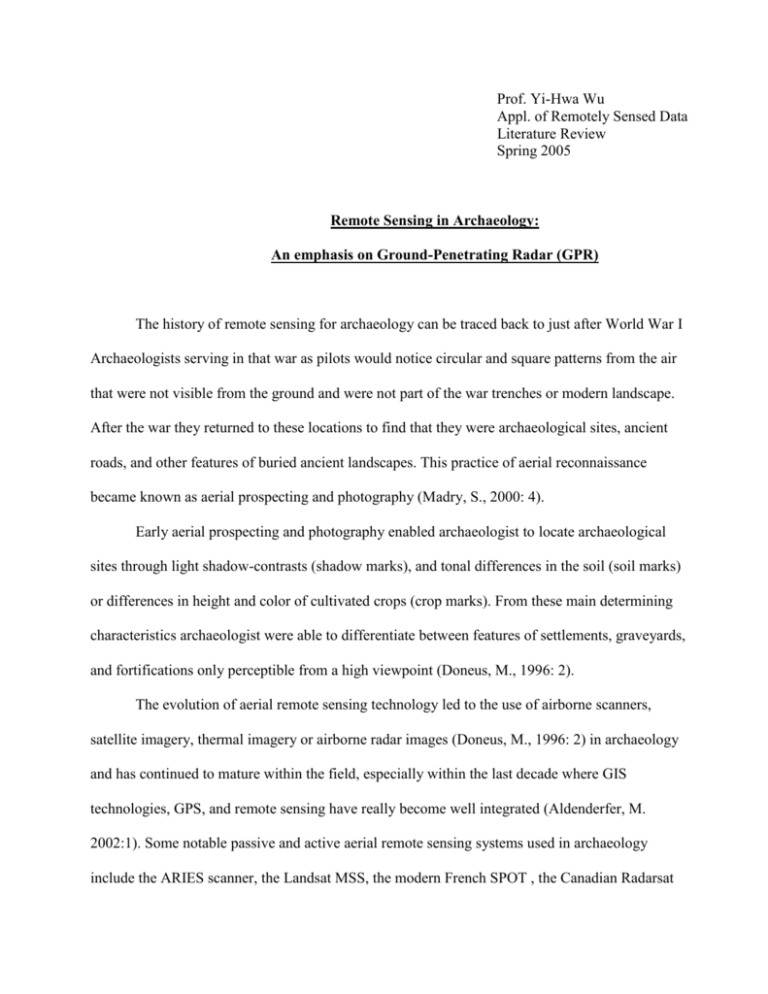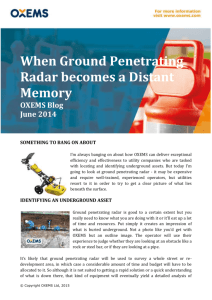1 Prof. Yi-Hwa Wu Appl. of Remotely Sensed Data Literature Review
advertisement

Prof. Yi-Hwa Wu Appl. of Remotely Sensed Data Literature Review Spring 2005 Remote Sensing in Archaeology: An emphasis on Ground-Penetrating Radar (GPR) The history of remote sensing for archaeology can be traced back to just after World War I Archaeologists serving in that war as pilots would notice circular and square patterns from the air that were not visible from the ground and were not part of the war trenches or modern landscape. After the war they returned to these locations to find that they were archaeological sites, ancient roads, and other features of buried ancient landscapes. This practice of aerial reconnaissance became known as aerial prospecting and photography (Madry, S., 2000: 4). Early aerial prospecting and photography enabled archaeologist to locate archaeological sites through light shadow-contrasts (shadow marks), and tonal differences in the soil (soil marks) or differences in height and color of cultivated crops (crop marks). From these main determining characteristics archaeologist were able to differentiate between features of settlements, graveyards, and fortifications only perceptible from a high viewpoint (Doneus, M., 1996: 2). The evolution of aerial remote sensing technology led to the use of airborne scanners, satellite imagery, thermal imagery or airborne radar images (Doneus, M., 1996: 2) in archaeology and has continued to mature within the field, especially within the last decade where GIS technologies, GPS, and remote sensing have really become well integrated (Aldenderfer, M. 2002:1). Some notable passive and active aerial remote sensing systems used in archaeology include the ARIES scanner, the Landsat MSS, the modern French SPOT , the Canadian Radarsat 2 (Madry, S., 2000: 5), Synthetic Aperture Radar (SAR), and Thermal Infrared Multispectral Scanner (TIMS) (Sever, T., 1998:1). These systems have been very useful to archaeology through the use of thermal data and the recording of energy reflected from radio waves beamed to the ground. Measuring thermal differences in the soil can be an indicator of buried stone structures, as these can act as passive solar collectors during the day, soaking up the heat, and then releasing this heat in the afternoon and evening (Madry, S., 2000: 5). Beamed radio waves or Radar is sensitive to linear and geometric features on the ground, particularly when different radar wavelengths and different combinations of the horizontal and vertical data are employed. Different wavelengths are sensitive to vegetation or to ground surface phenomena. In dry, porous soils, radar can penetrate the surface (Sever, T., 1998:1). Though the aerial remote sensing systems have provided primary assistance in locating archaeological sites in vast lanscapes, once on the archaeological site an archaeologist is really limited as to determining where relatively deep buried archaeological features are located and where major excavation should begin. Archaeologists have often been left to randomly shovel test a site to begin major excavations of buried archaeological features. This can often lead to imprecisely altering or destroying an archaeological site more than is necessary for accurately analyzing ancient human behavior. This problematic issue in archaeology is increasingly being resolved through the integration of near-surface remote sensing and intra-site analysis at archaeological sites. Nearsurface sensing refers to a suite of geophysical sensing techniques, including ground-penetrating radar, electrical resistivity, proton magnetometry, fluxgate and cesium gradiometry and other methods. These technologies are used to get a picture of what may lay below the ground surface 3 before an excavation begins. They are a kind of remote sensing for a single archaeological site. Intra-site analysis refers to the examination of how artifacts and cultural features are distributed within a single site (Aldenderfer, M. 2002:1). The method of special interest here is ground-penetrating radar (GPR) or also known as Subsurface Interface Radar (SIR®) Systems and Electromagnetic Induction Instruments (EMI) (GSSI, Inc. 2005: www.geophysical.com). Other geophysical sensing methods such as magnetometers, resistivity and electro-magnetic conductivity can produce maps of buried features, but ground-penetrating radar (GPR) is the only technique that can potentially make maps in threedimensions (Conyers, L.B., Ernenwein, E.G., & Bedal, L. 2002:1). Control box with imaging screen Antenna Fig. 1 (Conyer, L.B.:2000, http://www.du.edu/~lconyer/sir2000_400MHz.jpg) GPR accurately maps the spatial extent of near-surface objects and archaeological features or changes in the matrix of a site and ultimately produce images of those materials. Radar waves are sent in pulses from a surface antenna, reflected off buried features, or soil units, and detected back at the source by a receiving antenna (Conyers and Goodman, 1997: 23). 4 Fig. 2 (Conyer, L.B.:2000, http://www.du.edu/~lconyer/what_is_gpr.htm) As radar pulses are transmitted through various materials onto buried target features, their velocity changes depending on the physical and chemical properties, and water saturation of the object (Conyers and Goodman, 1997: 23). The greater the contrast between two materials at a subsurface interface, the stronger the reflected signal and resulting high amplitude reflected wave (Conyers, L.B., Ernenwein, E.G., & Bedal, L. 2002:6). Fig. 3 Raw reflection wave profiles (Conyers, L.B., Ernenwein, E.G., & Bedal, L. 2002:6) 5 When the travel time of the radar pulses are measured, and their intra-ground velocity known, then distance or depth of the ground can be accurately measured to eventually render a 3-D data set (Conyers and Lucius 1996). The depth at which the radar energy can penetrate the ground and the energy resolution it reflects is partially controlled by the frequency of the radar energy transmitted (Conyers and Goodman, 1997: 40). Fig. 4 (Conyers, L.B., Ernenwein, E.G., & Bedal, L. 2002:3) The frequency controls both the wavelength of the generated wave and extent of the signal spread and attenuation in the ground. In general the greater the necessary depth of a survey the lower the frequency antenna will be used. Though more depth also means lower resolution and vice versa. The depth penetration of Low frequency antennas (10-120 MHz) will reach a depth of 50 meters but can resolve only large subsurface features such as walls or columns, in contrast the depth penetration of a 900 Mhz antenna is about 1 meter or less but reflections can provide a resolution to features down to a size of a few centimeters. Therefore the archaeologist makes the selection of the antenna used in a particular ground-penetrating radar survey. The decision comes after careful evaluation of any previously known ground characteristics, and current soil characteristics such as 6 porosity and water saturation. The most common GPR frequencies used for archaeological purposes are between 200 and 900 MHz (Conyers, L.B., Ernenwein, E.G., & Bedal, L. 2002:3). The images generated by reflected GPR data is in a 2-D profile where depth is represented on the X-axis and distance along the ground surface on the Y-axis. Fig. 3 Raw reflection wave profiles (Conyers, L.B., Ernenwein, E.G., & Bedal, L. 2002:6) Multiple 2-D profiles are generated from the amplitude of the reflections where the antennas were moved along a transect and throughout a closely spaced grid. These 2-D profiles are stacked together in a process called amplitude slice-map analysis where they can be correlated to produce high resolution maps of the subsurface (Conyers, L.B., Ernenwein, E.G., & Bedal, L. 2002:3). Transects Fig. 5 Multiple 2-D profiles (Conyers, L.B., Ernenwein, E.G., & Bedal, L. 2002:3) 7 If these amplitude changes interpreted from the subsurface map can accurately be related to the presence or absence of buried features and stratigraphy then a 3-D reconstruction of the subsurface environment can be rendered. From this 3-D rendition stratigraphic layers could be identified in vertical profiles as distinct horizontal reflections and differentiated from other features such as walls and void spaces (Conyers, L.B., Ernenwein, E.G., & Bedal, L. 2002:3). Fig. 6 Amplitude time-slices-Blue areas denote little or no radar reflection, indicating homogeneous material. The red-green areas are higher amplitude reflections, indicating the presence of highly reflective material surrounded by sand or soil (Conyers, L.B., Ernenwein, E.G., & Bedal, L. 2002:4). As archaeologists increasingly implement geophysical techniques, such as GPR, in their archaeological methods the margin of error for accurately predicting potential excavations becomes very small. Moreover, the altogether need for excavation also becomes increasingly less as more precise modeling leads to archaeological questions being answered with a minimum of excavation. Also, as technology becomes more efficient and geophysical maps become more detailed accurate renditions with higher quality images can be produced over smaller areas of interests. Profiles and rendered images can be tested and correlated with excavation data, and based on results accurate predictive modeling with geophysical maps can be implemented for future excavations to answer archaeological questions more decisively. 8 References Aldenderfer, Mark 2002, GIS is rapidly becoming indispensable for archaeology. http://www.gisdevelopment.net/magazine/gisdev/2002/june/interview.shtml. Bedal, Leigh -Ann 2000. Paradise Found: Petra's Urban Oasis. Expedition, v. 42, n. 2, pp. 23-36. Conyers, Lawrence B. and Jeffrey E. Lucius 1996. Velocity analysis in archaeological groundpenetrating radar studies. Archaeological Prospection v. 3, pp.25-38. Conyers Lawrence B. & Dean Goodman 1997. Ground-penetrating Radar: An Introduction for Archaeologists. Walnut Creek, (CA): AltaMira. Conyers, Lawrence B. 2000, Ground Penetrating Radar in Archaeology: Using Ground Penetrating Radar to locate, map and study buried archaeological features. http://www.du.edu/~lconyer/. Conyers, L.B., Ernenwein, E.G., & Bedal, L. 2002, Ground-Penetrating Radar (GPR) Mapping as a method for planning excavation strategies, Petra, Jordan. http://e-tiquity.saa.org/%7Eetiquity/1/. e-tiquity, n. 1. Doneus, Michael 1996, The Aerial Archive: Introduction to Aerial Archeology. http://www.univie.ac.at/Luftbildarchiv/intro/aa_aaint.htm. GSSI, Inc. 2005: www.geophysical.com Madry, Scott 2000, GIS and Remote Sensing for Archaeology: Burgundy, France. http://www.informatics.org/france/rsgis.html. Sever, Tom 1998, Archeological Remote Sensing. http://www.ghcc.msfc.nasa.gov/archeology/remote_sensing.html.





